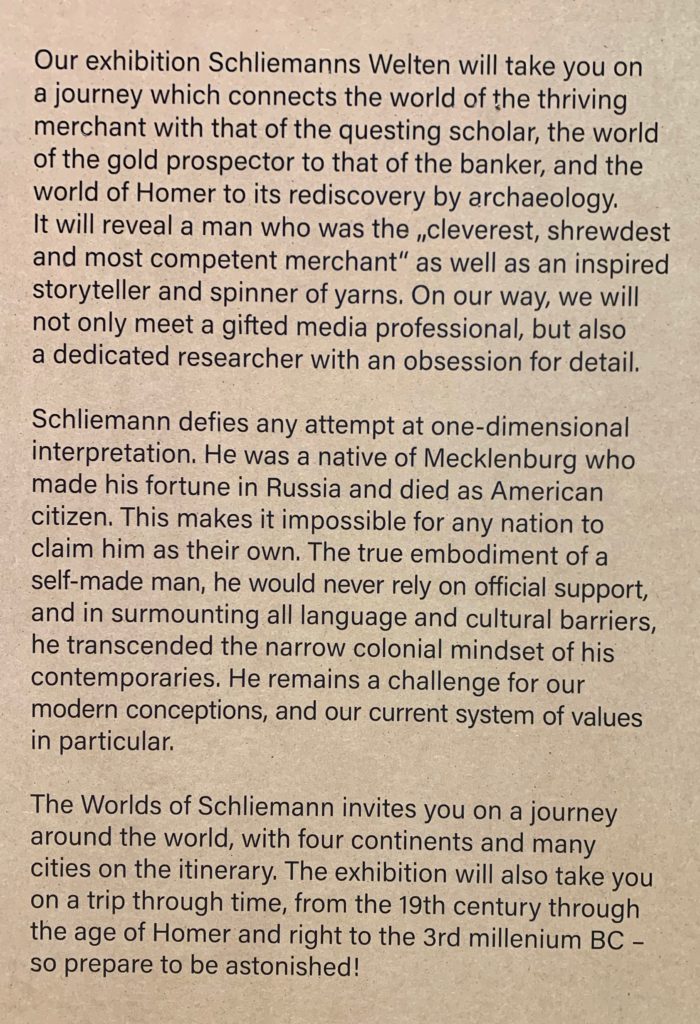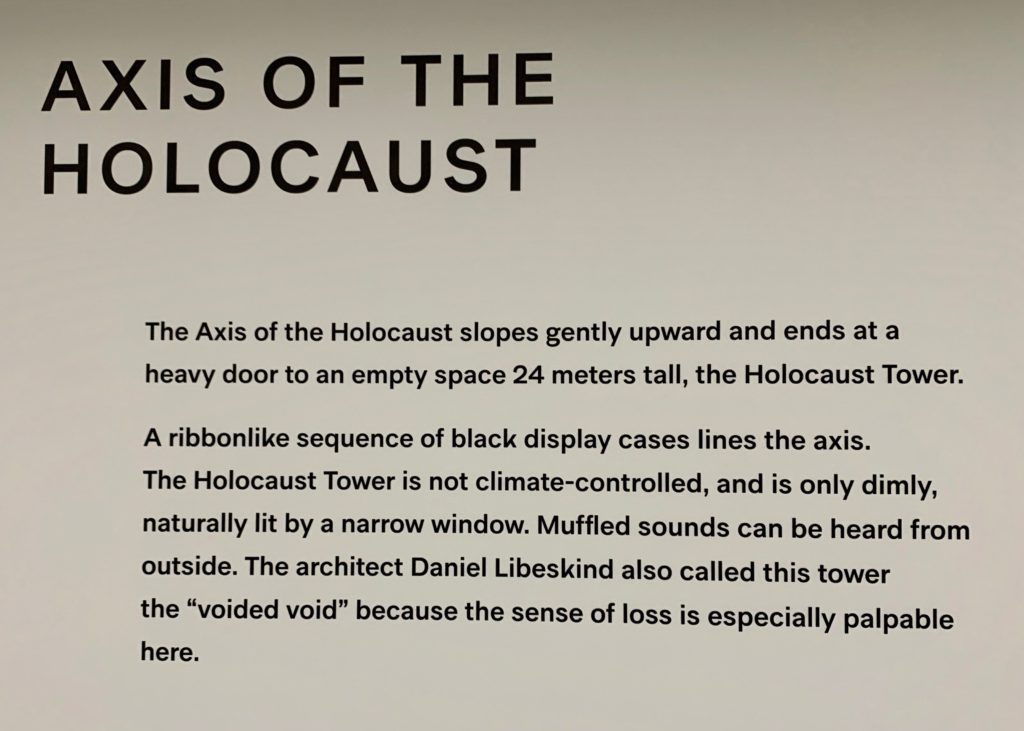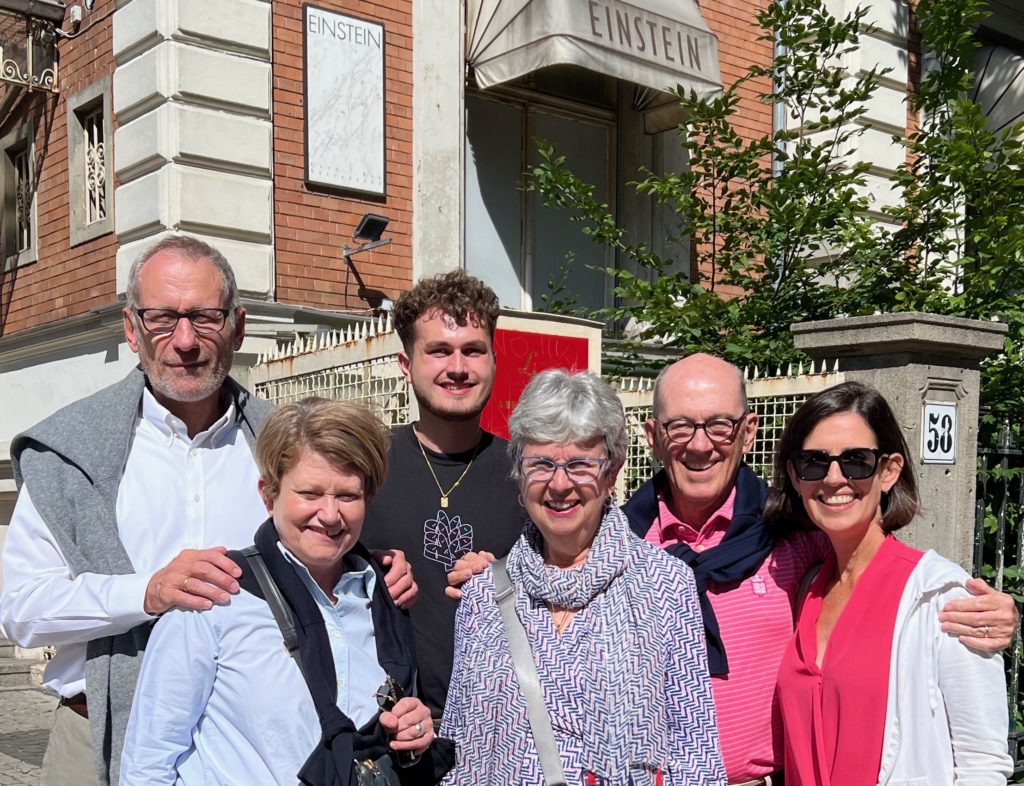Berlin Friends
 Beatrice and Jürgen not only met our train at the main station on July 15, they also escorted us to our hotel, pointing out landmarks along the way. Then they treated us to a wonderful dinner at a lovely sidewalk cafe where we drank real German beer and ate delicious schnitzel. Welcome to Berlin!
Beatrice and Jürgen not only met our train at the main station on July 15, they also escorted us to our hotel, pointing out landmarks along the way. Then they treated us to a wonderful dinner at a lovely sidewalk cafe where we drank real German beer and ate delicious schnitzel. Welcome to Berlin!
 After a bounteous breakfast Saturday morning at the NH Hotel on Friedrichstraße, we took a short cab ride to Museum Insel, a complex of museums in the heart of Berlin. At the Neues (new) Museum we encountered Schliemann’s Worlds, a celebration of the 200th anniversary of Heinrich Schliemann’s birth. His name was unfamiliar to me, but when I found out that he could speak twelve languages fluently and had a working knowledge of nine others, my interest was piqued. After becoming a trader in raw materials, Schliemann founded a bank in Sacramento CA, supplied the Russian army in the Crimean War, traveled the world, earned his doctorate in archeology in Paris, and fathered five children. He is best known for his quest to find the ancient city of Troy. He lived quite fully from 1822 – 1890. Here was how the museum introduced him:
After a bounteous breakfast Saturday morning at the NH Hotel on Friedrichstraße, we took a short cab ride to Museum Insel, a complex of museums in the heart of Berlin. At the Neues (new) Museum we encountered Schliemann’s Worlds, a celebration of the 200th anniversary of Heinrich Schliemann’s birth. His name was unfamiliar to me, but when I found out that he could speak twelve languages fluently and had a working knowledge of nine others, my interest was piqued. After becoming a trader in raw materials, Schliemann founded a bank in Sacramento CA, supplied the Russian army in the Crimean War, traveled the world, earned his doctorate in archeology in Paris, and fathered five children. He is best known for his quest to find the ancient city of Troy. He lived quite fully from 1822 – 1890. Here was how the museum introduced him:
 Astonished we were! Schliemann travelled to more than 50 countries, beginning with Amsterdam in the Netherlands, where we had just been. His travels covered 559,845 kilometers, equal to over 14 circumnavigations of the earth! He became my new Berlin friend!
Astonished we were! Schliemann travelled to more than 50 countries, beginning with Amsterdam in the Netherlands, where we had just been. His travels covered 559,845 kilometers, equal to over 14 circumnavigations of the earth! He became my new Berlin friend!
Next we visited the Pergamonmuseum and encountered the results of more archeology. Although the museum is currently under reconstruction, we were able to see the Ishtar Gate, constructed by King Nebuchadnezzar in 575 BCE. The gate was built over a brick-paved avenue, called the Processional Way, that ran more than half a mile. The site was unearthed by archaeologist Robert Koldewey, whose excavation of Babylon lasted from 1899 until 1917. The remnants of the original gate and Processional Way have been housed in Berlin’s Pergamon Museum since that institution’s founding in 1930. Iraq reconstructed the thoroughfare, but since the 1990s has actively sought the return of the original gate and associated artifacts. I had never seen a museum installation as large as this one.
The Pergamon also exhibits the Market Gate of Miletus, an ancient Greek city on the western coast of Anatolia. The Market gate was built in the second century CE and destroyed by an earthquake in the 10 or 11th century. In the early 1900s, it was excavated by a German archeological team, rebuilt, and placed on display in the museum in Berlin. Only fragments had survived and reconstruction involved significant new material, a practice which generated criticism of the museum. The gate was damaged in World War II and underwent restoration in the 1950s. Further restoration work took place in the first decade of the 21st century. The museum also housed a 360° Panorama by Yadegar Asisi: PERGAMON. Masterpieces from the Ancient Metropolis. It was entrancing to experience, but difficult to photograph.
Steve thought that two museums in one day were enough, but Lilli, Violet, and I continued on to the Jewish Museum in Berlin. Our report back to Steve was “Wow!” The museum, opened in 2001, is the largest Jewish museum in Europe. On 3,500 square meters of floor space, the museum presents the history of Jews in Germany from the Middle Ages to the present.
Daniel Liebeskind called his design for the museum “Between the Lines.” Three paths cross on the lower level: the Axis of Exile, the Axis of the Holocaust, and the Axis of Continuity. We felt the effects of the architecture. The floor is on an incline, the walls are slanted, and there are very few right angles. The floor plan of the upper stories follows a zigzag shape interrupted by empty spaces called voids. Liebeskind was born in 1946 in Poland. He emigrated first to Israel, then to New York. Of his architecture he says, “What is important is the experience you get, the interpretation is open.” I felt unsettled, disoriented, and challenged, just like many Jews surely felt.
Around 1800, Berlin was a center of the Haskalah, the Jewish Enlightenment. Its pioneers were scholars such as the philosopher Moses Mendelssohn. A small upper class of Jews achieved cultural acceptance. In many cases, such as that of the family of composer Felix Mendelssohn, that involved converting to Christianity. The original Jewish Museum in Berlin opened in 1933, when 500,000 Jews lived there. On Kristallnacht, November 9, 1938, the museum was forced to close and its collection was confiscated.
On September 9, 2001, the new Jewish Museum Berlin opened with a festive concert conducted by Daniel Barenboim. At the subsequent gala dinner, Federal President Johannes Rau and Museum Director W. Michael Blumenthal spoke to 850 prominent guests from politics, business and culture from Germany and abroad. The opening to the public was planned for September 11, 2001 and had to be postponed by two days because of the terrorist attacks on the World Trade Center in New York.
Over a delicious fish dinner at Seaside, we talked about what we had learned that day in three museums. A month later, I’m still processing all that information. Writing this blog requires me to edit my photos, do research, seek clarification, and ponder meaning.
On Sunday morning, July 17, we walked around the outdoor exhibits at Checkpoint Charlie, which was the gate to the American sector of divided Berlin and is now the name of the hotel where we stayed. This album contains 48 photos of information we saw displayed about events that span my life, from the end of WW II to the present. It was fun to see my daughter and granddaughter standing between sections of the infamous Wall. Another photo has special meaning to me. Mstislav Rostropovich, who spoke out in favor of regime critics and was stripped of his citizenship and expelled from the Soviet Union, celebrated the fall of the Wall by playing Bach at the Friedrich Street crossing on November 11, 1989. He later became Conductor of the National Symphony Orchestra in DC and we often heard him play and conduct.
My favorite part of our trip to Berlin was lunch that Sunday with my godson, Jasper Friedrich, and his parents at Cafe Einstein. That’s where Beatrice was on November 9, 1989 when she heard the Wall was falling. Jasper was born July 20, 2000 in Washington DC when his parents lived in Arlington VA. He was 14 when I last saw him in Berlin. Now he is pursuing studies in informatics at the University of Dresden; he will start an academic year in Venice beginning in September. In the midst of examinations. he made a special trip home so that we could all have lunch together. In another post, Familie Friedrich, you can see more about Jasper and his family. I am very proud to be his godmother.
Monday was our day to see official Berlin, from the Brandenburg Gate to the Reichstag. Lilli, Violet and I visited the Holocaust Memorial first; then walked around the Tiergarten park adjacent to the Brandenburg Gate and found its natural beauty quite peaceful.
Monday afternoon, we took a 3-hour tour of the Reichstag and learned how the German parliamentary system works. Lilli especially admired the glass dome British architect Norman Foster designed when the building was rebuilt after the German Reunification on October 3, 1990.
 Our time together with our daughter and granddaughter was not totally devoted to museums and famous places. While Lilli met a friend for dinner at a vegetarian restaurant, Steve and Violet took time to enjoy a game of gin rummy. Then we three went to a sidewalk cafe where the waiters and waitresses were dressed in lederhosen and dirndls and served delicious Austrian food.
Our time together with our daughter and granddaughter was not totally devoted to museums and famous places. While Lilli met a friend for dinner at a vegetarian restaurant, Steve and Violet took time to enjoy a game of gin rummy. Then we three went to a sidewalk cafe where the waiters and waitresses were dressed in lederhosen and dirndls and served delicious Austrian food.
Tuesday, July 19, was our last day in Berlin; a great send-off was Technik Museum, the German Museum of Technology. Check out this website for an overview. Then if you’d like to know more about the history of telecommunications, computers, sugar, automobiles, ships, and airplanes, check out my album of 79 photos. Here are six:
Late Tuesday afternoon Jürgen met us at the hotel and escorted us by subway and car to his home in Kleinmachnow. We were planning to take a picnic to a Biergarten and Beatrice had it all ready. Because the weather had turned hot, we opted to stay at home and I’m glad we did. Our recent visit to the Reichstag prompted a fascinating discussion of what it was like to move the capital of Germany from Bonn to Berlin after the Reunification of 1990. It’s hard to imagine moving an entire national government! Bea and Jürgen lived in Arlington VA from 1997 – 2000 and in Dubai UAE from 2000-2007. They missed some of the trauma their colleagues experienced, while managing to have a house designed and built in Kleinmachnow just in time for their return to Germany. Their new house is lovely and both seem to be thriving in their careers. Beatrice is a lawyer in the Federal Ministry of Education and Research; Jürgen is CEO of Germany Trade and Invest.
Jürgen drove us all the way back to the hotel, commenting on buildings we passed. The Tempelhof Airport, which was finished just in time for the 1936 Summer Olympics in Berlin, now stands empty, waiting for a new mission. The former Embassy of North Korea had been turned into a hostel for traveling students, but is now closed because of the sanctions Germany and the EU have against that country’s assets.
Vielen Dank Familie Friedrich! It was a great pleasure to have three visits with Bea and Jürgen, two dinners with Florentine, and a few hours with Jasper. Now we look forward to hosting any or all of you in Florida, Texas or Massachusetts. You are wunderbar Deutsche Freunde!






Leave a Reply